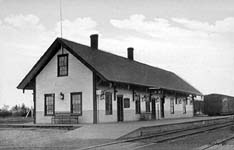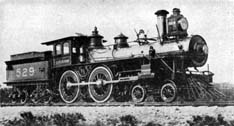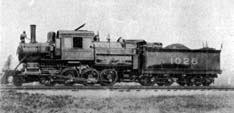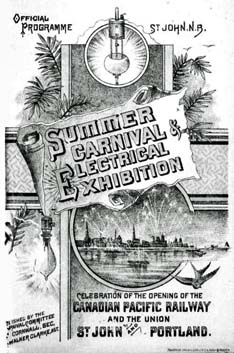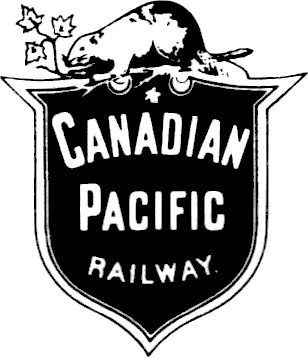
Home
Articles
Wilderness
Early Rail
Locomotive
The CPR
Engineers
Countess
New Brunswick
St. John
Steamships
Fundy
DAR
Credits
Background
Adequate transportation throughout what is now Canada was badly needed in its early days. A trip from the east to the west was a long and tiring affair. Frequently it took months to cross the prairies and the prairie schooners of the pioneer period drawn by the proverbial yokes of oxen afforded a slow and difficult method of travelling. There are men yet living who remember when a journey from Victoria to Halifax was almost as long as a trip from the Pacific Coast to England. A century ago it took a boat from ten to fourteen days, according to the weather conditions, to make a trip from Toronto to Montreal
of the pioneer period drawn by the proverbial yokes of oxen afforded a slow and difficult method of travelling. There are men yet living who remember when a journey from Victoria to Halifax was almost as long as a trip from the Pacific Coast to England. A century ago it took a boat from ten to fourteen days, according to the weather conditions, to make a trip from Toronto to Montreal . (Today it is a matter of a few hours.) In winter a stage drawn by its spanking team of "greys" plowed through the snow drifted roads. If our great grandfathers made fifty miles in a day, the adventure was talked over in the tavern for months.
. (Today it is a matter of a few hours.) In winter a stage drawn by its spanking team of "greys" plowed through the snow drifted roads. If our great grandfathers made fifty miles in a day, the adventure was talked over in the tavern for months.
New Brunswick was a wilderness, divided by long stretches of settlement, and here and there traversed by roads. Five nights were spent in travelling from the St. John River Valley to Chaleur Bay, and most of the journey was done by canoe. At as late a date as 1840 a traveller paid twenty shillings for the 65 miles on the route from St. John to Fredericton, and it cost £12 10 shillings to go from St. John to Quebec. The dangers were many, not the least highway robbery. The cost of transportation made it difficult for communities to dispose of their surplus products. Information on other parts of the country was meager, and second hand. Speedier transportation less affected by the weather conditions had become imperative.
The first move, as far as New Brunswick was concerned, was made at St. Andrews. In 1827, a public meeting was held there, and for the first time the project of building a railway, to be called the St. Andrews & Quebec Railway (SA&Q), to connect the Maritimes with Lower Canada, was seriously discussed.
After several years of stress and trial the project at last reached the stage of being formally approved by the New Brunswick Legislature. The company was incorporated, March 1836. It is interesting to note that the names of the incorporators of the line included several men who were afterwards famous. The prime movers were the Honourable Ward Chipman late Chief Justice of New Brunswick, Hon. Hugh Johnston future Attorney-General, Hon. J.R. Partelow later Provincial Secretary, and Charles Simonds, prominent citizen. These gentlemen were all of St. John. One expects, of course, to find the best brains of a community interested in any project which promotes progress, but this is an unusually formidable list.
The sum of £10,000 was given to aid the survey, and this work intrusted to a Captain Yule of the Royal Engineers. The line was to be laid with 45 pound U-rails and of narrow gauge. Some 14 miles of track had been constructed during the previous year. This work now went on.
The road's first locomotive was the "Pioneer", built by Robert Stephenson & Company at Newcastle-upon-Tyne, England, United Kingdom in 1850. This engine had outside cylinders, four-coupled driving wheels, and steam admission governed by a slide-valve, actuated by the Stephenson's link gear.
It is necessary to trace in detail the further progress of the SA&Q, pioneer road of New Brunswick, suffice to say that, despite many difficulties, it did make gradual progress so that, at the time of Confederation (1867), it had extended from St. Andrews to St. Stephen, and running trains regularly. This road was subsequently absorbed by the New Brunswick Railway (NBR), which in turn became an integral part of the Canadian Pacific Railway (CPR), thus giving the latter road its place in the early history of the province.
In 1864, the New Brunswick Legislature passed and act, offering a bonus of $10,000 a mile to certain sections of the province, to aid them in building railways. With this encouragement a line from St. John to the Maine Border, with a branch to Fredericton, begun in 1865 was known as the "Western Extension", and the road opened as far as City Camp (now McAdam Junction) in 1869.
The CPR, was incorporated by and Act of Parliament of Canada, embracing the contract and charter to carry out the obligation the Canadian Government assumed, on admission of the Province of British Columbia into the union with the other provinces of the Dominion, and to connect the western most coast with the railway system of Canada.
The idea of a Canadian transcontinental system of transportation was no new thing. A route to the Pacific via the inland waterways had been suggested as early as 1829. Carmichael Smyth, in 1849, had advocated the construction by convict labour of a road to the western coast, and the prophecy of the Hon. Joseph Howe of Halifax, in 1850, that many then living would be able to travel from the Atlantic to the Pacific in five or six days, was as common in New Brunswick as it was in Nova Scotia.
The CPR syndicate was formed in September 1880. The Dominion Government contracted with this syndicate, who undertook to build the line within ten years from date of contract, receiving a grant of $25,000,000 and 25,000,000 acres of land, and being permanently exempt from all forms of taxation on the railway or capital, with a twenty year exemption from taxation on its land. The syndicate also received the 713 miles of line already constructed or contracted for under other attempts previously made to construct the road.
On 17 Feb 1881, the Canadian Pacific Railway Company was incorporated with Mr. George Stephen (later Lord Mount Stephen) as president. In June of that year the rattle and roar of the first construction train was heard. On 7 Nov 1885, five years ahead of the contract, the stroke of the heavy sledge in the hands of Sir Donald A. Smith (afterwards Lord Strathcona) echoed through the Rockies at Craigellachie, driving the Last Spike, "Clinching the rivets of an Empire down". Between these two dates lies a tale which the company can look back upon with pardonable pride, as an epic in which are blended stern fortitude in the face of great difficulties, unwavering faith in the ultimate success of a project which many men ridiculed as a dream of those who were doomed to see their work perish in the western wilds, an exultant endeavor on the part of men who, with their strong hands thrust the road onward over that immensity of mountain, rock, and prairie. On 28 Jun 1886, the line was opened for through traffic.
The recent retirement of three of the oldest locomotive engineers in the service of the CPR recalls the old construction days of the west, when they fired and piloted the old wood-burners used in construction work. They are Tom Penhale, a veteran engineer of 1881, James Fisher, who entered the services of the CPR in 1882, and Henry Hardy, who first worked for this road in 1887.
Jim Fisher had a most enviable record as a railroader. He started as a fireman on the old Intercolonial, at Truro, Nova Scotia, in 1871, and in the course of the fifty-one years he had been on the road he had covered over two million miles in the cab of an engine. He joined the CPR in 1882, worked as an engineer in construction, and he had the distinction of taking the first construction train over the initial pile bridge across the South Saskatchewan River at Medicine Hat. Three years later he pulled the first transcontinental train over the same bridge with engine number 124, and some time after with the same engine, he made the fastest run ever recorded on his division, "doing" from Gleichen to Medicine Hat, a distance of 125 miles, in two hours and twenty-five minutes, with four stops and a delay occasioned by a hot box. He was at the "front" when the rails met at Craigellachie in 1885, and it was also his privilege to take the first train equipped with air brakes from Winnipeg to Medicine Hat. He was promoted to passenger service in 1886, and it was his proud boast that during the 36 years in which he piloted passenger trains he never had a passenger or a trainman killed while he occupied the cab.
Henry Hardy joined the road 36 years ago. In three years he was appointed fireman on construction work on the Prince Albert branch. He took his first engine from Moose Jaw to Canmore in 1897 and from the following year worked as engineer from Medicine Hat, being promoted to regular service in 1906.
These men helped to nurse the railroad in its infancy, and have watched it grow from a speculation involving the fate of a nation to one of the nations' greatest assets.
An early locomotive of the Canadian West was the CPR's "Countess of Dufferin". It was taken over from the Northern Pacific, and came down the Red River from the United States. Baldwin was the builder, this locomotive being typical of the engines of the early seventies, then the glory of the railroads. It can now be seen in front of the CPR station in Winnipeg
from the United States. Baldwin was the builder, this locomotive being typical of the engines of the early seventies, then the glory of the railroads. It can now be seen in front of the CPR station in Winnipeg .
.
From Jun 1886, thence forward the work of expansion never ceased, and it was not long before a vast wilderness was enmeshed and tamed for ever in a network of steel.
Once the company decided upon St. John as its Maritime terminus, the next step was to construct, lease, or buy trackage into that city. The officials of the company turned their attention to acquiring the New Brunswick Railway (NBR).
(NBR).
This NBR, which it will be recalled, had absorbed the St. Andrews & Quebec Railway (SA&Q), which ran from a point near Fredericton to Edmonston. Like most of the pioneer lines of Canada it was narrow gauge. In 1882, the CPR obtained a controlling interest in the line, and the Hon. Isaac Burpee was appointed president. Gradually the NBR absorbed all the lines on the western side of the St. John River, except the Grand Southern (afterwards the New Brunswick Southern) owned by Russell Sage, of New York, famous American pioneer railroader, and the St. John Bridge and Extension Company, which were acquired in later years. Thus, commencing in 1882, a unifying progress went on for several years and steadily amalgamated the confusing web of numerous little roads in New Brunswick into one great whole tributary to the CPR.
The great event in relation of the company with St. John came on 3 Jun 1889, with the opening of the "short line" from Montreal to St. John, which marked as it were, the official entry of the railway into the city. For many months St. John had been awaiting this train with the keenest anticipation. At 20:30 on 2 Jun 1889, Engineer James Wells at the throttle, Conductor John Cunningham in charge of the train drawn by locomotive number 174, and consisting of four cars, pulled out from Montreal. There was nothing ostentatious about its make-up or its progress, but after an uneventful journey, it steamed into St. John, Union Depot, at 15:15 on the 3 Jun 1889, with Mr. Thomas McKenna, (who still resides in West St. John) as engineer, a crowd of nearly 2,000 jubilant citizens was awaiting it. The train was received with hearty cheers and thoroughly inspected from end to end. Newspapers printed detailed descriptions of the train and hailed its advent in glowing terms.
The citizens did more than merely meet the train. They decided to have a celebration to mark the occasion. Accordingly, the announcement was made of a "Summer Carnival and Electric Exhibition to be held in St. John, N.B., Canada, opening 22 Jul 1889, to celebrate the opening of the Canadian Pacific Railway (Short Line) to St. John." Old programs and posters still existing give lavish descriptions of the splendors which were offered. The opening ceremony included an address by the chairman, Henry J. Thorne, Esq., which was preceeded by the firing of a salute of one gun by electricity in honour of the Lieutenant Governor, Sir S.L. Tilley, K.C.M.G., C.B., an address by the Lieutenant Governor, who opened the exhibition by firing three guns by electricity. Then came the National Anthem, played with variations, by an electric piano, and the show, so to speak was "on". It lasted several days, with athletic sports, monster trade processions, regatta, mammoth marine pageant, and pyrotechnic display in the harbour, torch-light parade on the hills, theatrical entertainments by well known companies, and many other attractions.
At any rate, the affair was a great success, the CPR issued special rates for the occasion and everyone was satisfied. Thus came the CPR to St. John.
In 1895, the Old Beaver Line of Steamships, inaugurated its first service to St. John. The CPR had a special interest in this event because of the fact the old Beaver Line was subsequently absorbed by the Elder Dempster, those vessels on their Canada to England route later formed the nucleus of the CPR's Atlantic fleet.
The creation of the Company's Atlantic fleet, (their ships had been sailing the Pacific) was accomplished by a stroke of the pen. The fifteen fine steamers maintained by the Elder Dempster Line on the Canada to England route were purchased outright at a cost of nearly £1,500,000. These ships ranged from 4,000 to nearly 10,000 tons. Freight and passenger services were established between Liverpool, Bristol, London, Antwerp, and Canada, this was in 1903. In the years following, this fleet was constantly increased and improved until it reached the imposing proportions of today.
In 1913, the CPR established its Bay of Fundy service. This service was taken over from the Dominion Atlantic Railway Company (DAR), and plies between St. John, New Brunswick, and Digby, Nova Scotia, some 45 miles away. It was first maintained by the S.S. Yarmouth , later reinforced by the S.S. St. George
, later reinforced by the S.S. St. George until the latter was chartered in December 1914, by the Imperial Government for war purposes, the Yarmouth carrying on until May 1916, since then the S.S. Empress
until the latter was chartered in December 1914, by the Imperial Government for war purposes, the Yarmouth carrying on until May 1916, since then the S.S. Empress has maintained the service.
has maintained the service.
The CPR as a transportation system, has increased its trackage, between 1896 and 1926, from 4,315 miles to nearly 20,000 miles, its locomotives from 336 to 2,500, its freight cars from 7,835 to 90,542, its passenger cars number 3,000, and it has built up a fleet of 86 steamers. It controls in addition many smaller roads, the most important being, the Minneapolis St. Paul & Sault Ste. Marie, and the Duluth South Shore & Atlantic Railroads in the west, and the Montreal & Atlantic, the New Brunswick Coal & Railway Company, and the Dominion Atlantic Railway in the east.
This latter road follows the unique practice of naming its locomotives, the engines as a rule, taking their names from places along the line. Until recently the engines were painted a dark red, but now most of the locomotives are CPR and are painted black. Light locomotives are used as a rule, Standard and Ten-wheelers being the favourite types. One of the best known trains in Eastern Canada is the Bluenose , an express train which operates on this road. It runs over the Company's rails, from Yarmouth to Windsor Junction, thence Canadian National to Halifax.
, an express train which operates on this road. It runs over the Company's rails, from Yarmouth to Windsor Junction, thence Canadian National to Halifax.
C. Warren Anderson - Saint John and the Canadian Pacific Railway, The Railway and Locomotive Historical Society Bulletin No. 15 (November, 1927), pages 52-59, published by the Railway & Locomotive Historical Society (R&LHS).
The railway station at St. Andrews by the Sea - Circa 1890 Photographer?




